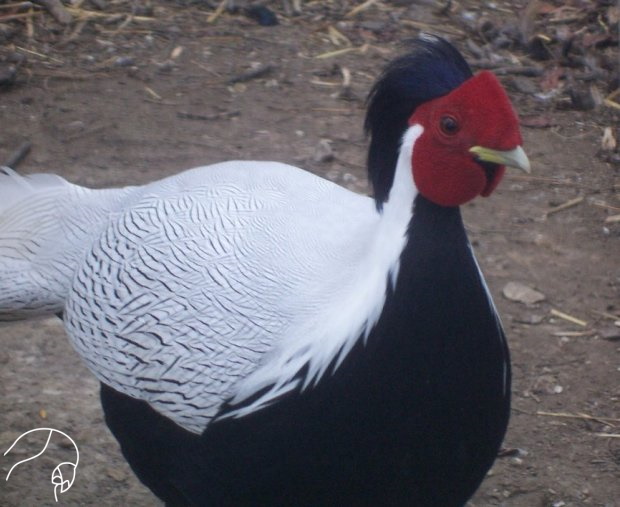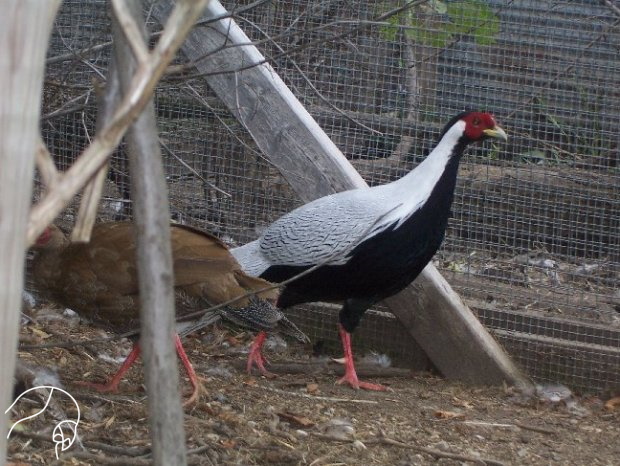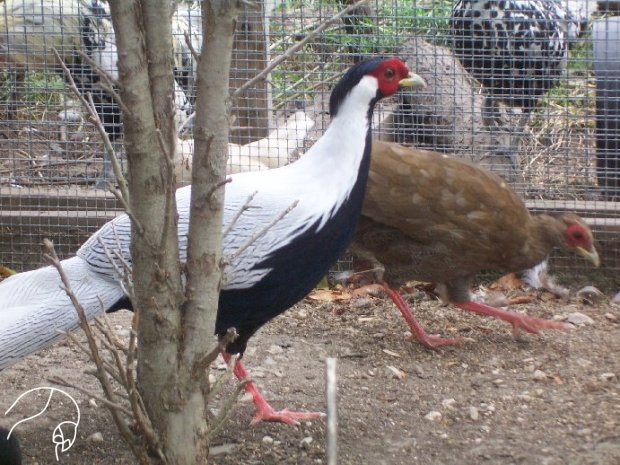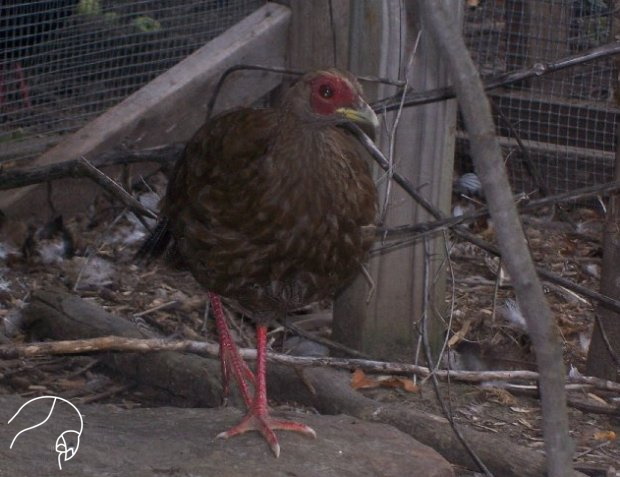Silver Pheasant (Lophura nycthemera)
The Silver Pheasant is my all time favoite bird species! They are a large majestic pheasant native to China and southeast Asia. There are 15 subspecies that live in a diversity of habitats from grasslands to forests. It is well established and a very popular aviary bird.






Scientific classification: Kingdom Animalia, Phylum Chordata, Class Aves, Order Galliformes, Family: Phasianidae, Genus: Lophura, Species: Lophura nycthemera
Other Names: No other general common names, see the list of subspecies for geographical names.
Range: South-western China, eastern Burma, southern Vietnam, southwestern Cambodia, southeastern Thailand, northern Laos and the island of Hainan. Humans have attempted to establish Silver Pheasants at various locations around the world with mixed results. Most birds observed outside of their native range are escaped aviary birds.
Subspecies: 15 subspecies according to Johnsgard, 1999. True Silver Pheasant (Lophura nycthemera nycthemera) being the most commonly claimed in aviaries. The True Silver is the largest of the subspecies and is found in southeastern China. The other subspecies include the Lewis' Silver Pheasant (L. n. lewisi), the Annamese Silver Pheasant (L. n. annamensis), the Boloven Silver Pheasant (L. n. engelbachi), the Bel's Silver Pheasant (L. n. beli), the Berlioz's Silver Pheasant (L. n. berliozi), the Ruby Mines Silver Pheasant (L. n. rufipes), the Rippon's Silver Pheasant (L. n. ripponi), the Jones' Silver Pheasant (L. n. jonesi), the Western Silver Pheasant (L. n. occidentalis), the Lao Silver Pheasant (L. n. beaulieui), the Fokien Silver Pheasant (L. n. fokiensis), the Hainan Silver Pheasant (L. n. whiteheadi), Szechwan Silver Pheasant (L. n. omeiensis) and the Rang Jiang Silver Pheasant (L. n. rongjiangensis).
Two additional subspecies that are often considered Silver Pheasants are the Crawfurd's Kalij Lophura nycthemera crawfurdi and the Lineated Kalij Lophura nycthemera lineata. Recent DNA work published in the Ibis, notes that these races should be belong with leucomelanos instead of nycthemera.
Habitat: Diverse, both grasslands and bamboo, evergreen and decidous forests.
Status in Wild: Varies among races. nycthemera and fokiensis are considered common and stable, others such as annamensis, whiteheadi and engelbachi have smaller natural ranges and are vulnerable to habitat loss.
Aviculture: Bold, curious, beautiful and majestic, the Silver Pheasant is a perfect aviary bird and great for beginners to pheasant keeping. Male Silvers have a reputation of being aggressive towards their keepers and hens. I've had many males that I had to ward off with a stick or broom and others that were perfectly harmless, even taking food from my hand. They are big birds that are extremely tough and hardy. We once had an ice storm and had to go pull the Silvers off the roost to place them inside the shelter, only to see them back outside again on the roost within an hour! Many keepers also allow Silvers free range on their property.
It is recommended to allow the hens to go broody, as they are great mothers and is very interesting to observe the family behavior of this species. The male, despite his reputation of being mean, will participate with the rearing of the chicks. Clutch size varies from 6 to 15 eggs with about a 27 day incubation period. The chicks do grow quickly and are able to fly at only a few days.
I've seen Silvers kept in nearly all sizes of aviaries. An ideal aviary is one that is at least 200 square feet, landscaped with various shrubs, grasses, logs and rocks. They are extremely hardy and tough birds, only a minimal shelter is required during the winter months. Ample shade is recommended during the summer.
The captive diet of adult Silver Pheasant consists of a game bird crumble or pellet - we used Purina® Game Bird Maintenance at 12.5% protein during the fall and winter months and increased the protein level to 18% in late winter to early Fall. The chow was mixed with various grains and seeds year round. Whole fruits such as apples, pears, blueberries, grapes, and sliced melons are offered every other day; leafy vegetables such as romaine, leaf, endive, kale, clover, dandelion are offered daily (some only in season); other veggies are chopped or giving whole such as soft corn, peas, broccoli, carrots, zucchini, sweet potato on days when fruit isn't offered. Live food such as mealworms, waxworms, dubia roaches, and crickets are given once a week during the spring and these are dusted with reptile calcium powder. Treats also include the occasional hard-boiled egg, millet sprays, and I admit, I've shared some of my own leftovers a time or two! Poultry grit should be available at all times. For the chicks, a high protein crumble is offered, starting at 30% and gradually decreasing with age.
Interesting Facts: They are well known in ancient Chinese art and poetry. The Silver Pheasant has also been referred to as the White Phoenix. The origin of the genus name Lophura is from Ancient Greek meaning "crest" and "tail".
- Faisan Plateado - Spanish Faisanes del mundo
- Silver Pheasant - BirdLife International Factsheet
- Silver Pheasant - eBird
- Silver Pheasant - gbwf.org
- Silver Pheasant - iNaturalist
- Silver Pheasant - Thai National Parks
External Links
- Altitudinal differences in habitat use by Siamese Fireback Lophura diardi and Silver Pheasant Lophura nycthemera in Khao Yai National Park, Thailand - © 2009 World Pheasant Association. International Journal of Galliformes Conservation, 1, 18-22
- Changes in the Status of Lophura Pheasants in Khao Yai National Park, Thailand: A Response to Warming Climate? - © 2007 The Author(s) Journal compilation © 2007 by The Association for Tropical Biology and Conservation
- Comparison of roosting habitat characteristics of two sympatric pheasants during springtime at Dazhong Mountain, southwestern China - © Chinese Birds 2010, 1(2):132-140
- Hybrid origin of the Imperial Pheasant Lophura imperialis (Delacour and Jabouille, 1924) demonstrated by morphology, hybrid experiments, and DNA analyses - © Biological Journal of the Linnean Society, 2003, 80, 573-600.
- Mitochondrial DNA diversification among the subspecies of the Silver and Kalij Pheasants, Lophura nycthemera and L. leucomelanos, Phasianidae - © 2003 British Ornithologists' Union, Ibis, 145 (online), E1-E11
- Phylogeography of Silver Pheasant Lophura nycthemera across China: Aggregate effects of refugia, introgression and riverine barriers - © 2013 Dong, Lu & Heckel, Gerald & Liang, Wei & Zhang, Yanyun. Molecular Ecology. 22. 10.1111/mec.12315.
Hosted PDF Files
The beauty and genius of a work of art may be reconceived, though its first material expression be destroyed; a vanished harmony may yet again inspire the composer, but when the last individual of a race of living things breathes no more, another heaven and another earth must pass before such a one can be again. - William Beebe, 1906
Animal Wonders
We depend on our programs & donations to help fund the care and housing for our animals, most of which are either rescues or surrenders. We seem to be always taking in new animals that need a home or different situation, their care adds up. If you would like to help support Animal Wonders, it would be greatly appreciated. We are always in need of donations, caging material, lumber, crates, aquariums, straw, & newspapers.
Contact
Animal Wonders,LLC
Address : 405 W. 10th St, Holden, MO 64040
E-mail : info@animalwonders.net
Phone : 816-807-4748

